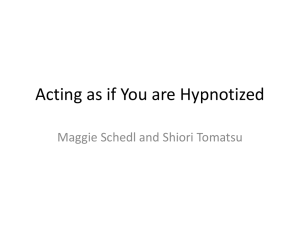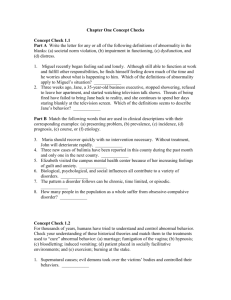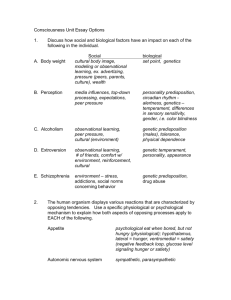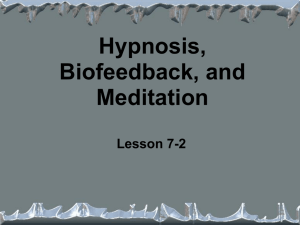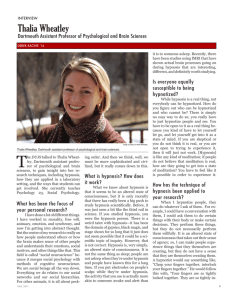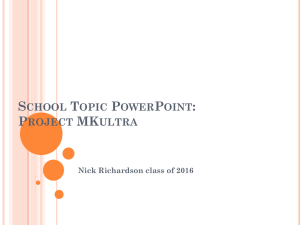67 Hypnotically influenced memory and the
advertisement
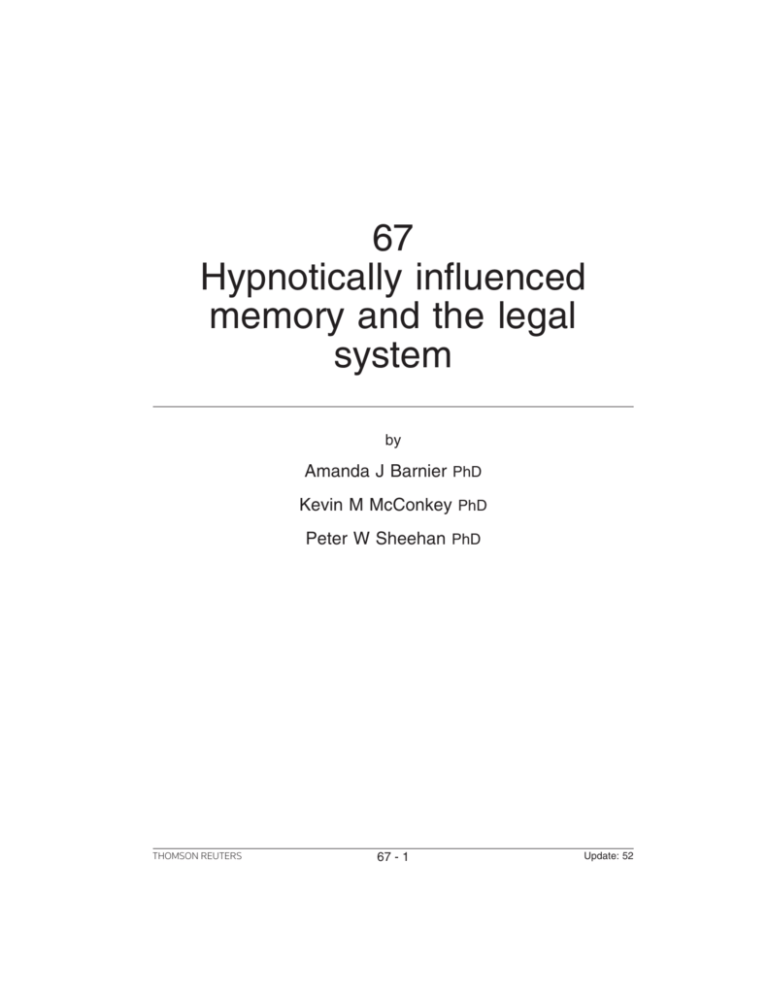
67 Hypnotically influenced memory and the legal system by Amanda J Barnier PhD Kevin M McConkey PhD Peter W Sheehan PhD THOMSON REUTERS 67 - 1 Update: 52 EXPERT EVIDENCE Author Information Amanda J Barnier, PhD, is an Australian Research Council Australian Research Fellow, Macquarie University, Sydney, Australia. A graduate of Macquarie University and the University of New South Wales, she has held academic positions in Australia and the United States. Associate Professor Barnier is a Member of the Australian Psychological Society and has received its Early Career Award, as well as the Australian Skeptics Eureka Prize for Critical Thinking. Kevin M McConkey, PhD, is Deputy Vice-Chancellor (Academic and Global Relations), The University of Newcastle, Newcastle, Australia. A graduate of the University of Queensland, he has held academic positions in Australia, Canada and the United States. Professor McConkey is an Honorary Fellow and has served as President of the Australian Psychological Society; he is a Fellow of the Academy of the Social Sciences in Australia. Peter W Sheehan, PhD, is former Vice-Chancellor, Australian Catholic University, Sydney, Australia. A graduate of the University of Sydney, he has held academic positions in Australia and the United States. Professor Sheehan is an Honorary Fellow and has served as President of the Australian Psychological Society; he is a Fellow and has served as President of the Academy of the Social Sciences in Australia; and is an Officer of the Order of Australia for services to education, research and psychology. The original preparation and revision of this chapter was supported in part by independent grants from the Australian Research Council to Amanda J Barnier, Kevin M McConkey, and Peter W Sheehan. We are grateful to Michael Connors for research assistance in the preparation of the current chapter. Chapter 67 © A Barnier, K McConkey and P Sheehan Published with permission of the authors THOMSON REUTERS 67 - 2 Expert Evidence TABLE OF CONTENTS INTRODUCTION .............................................................................................................. [67.60] HYPNOSIS AND ITS APPLICATION......................................................................... [67.110] Hypnotic ability.............................................................................................................. [67.130] Hypnotic techniques ..................................................................................................... [67.150] Clinical use of hypnosis ................................................................................................ [67.170] Guidelines and regulation ............................................................................................. [67.190] Hypnosis in the forensic context .................................................................................. [67.210] Regulation and impact of “hypnotic-like” practices....................................................... [67.230] Hypnosis to recover memory of childhood sexual abuse ............................................ [67.250] PROPERTIES OF HUMAN MEMORY ....................................................................... [67.300] What memory is............................................................................................................ [67.320] What memory is for ...................................................................................................... [67.340] A balance in memory .................................................................................................... [67.360] How memory works ...................................................................................................... [67.380] The essence of remembering....................................................................................... [67.400] Influences on memory .................................................................................................. [67.420] Judging memories ........................................................................................................ [67.440] THE INFLUENCE OF HYPNOSIS ON MEMORY ................................................... [67.490] Hypnosis and increased memory ................................................................................. [67.510] Hypnosis and distorted memory ................................................................................... [67.530] Hypnosis and created memory..................................................................................... [67.550] Hypnosis and recovered memory................................................................................. [67.570] Hypnosis and deceit ..................................................................................................... [67.590] Hypnosis and confidence in memory ........................................................................... [67.610] Hypnosis and clinical amnesia ..................................................................................... [67.630] Hypnosis and other techniques of memory recovery................................................... [67.650] Summary implications for forensic hypnosis ................................................................ [67.670] SELECTED CASES AND LEGAL DECISIONS IN AUSTRALIA......................... [67.720] Influence of United States cases.................................................................................. [67.740] Admissibility of hypnotically refreshed memory R v Jenkyns ............................................................................................................. [67.760] R v Haywood, Marshall and Roughley .................................................................... [67.780] R v G........................................................................................................................ [67.800] GUIDELINES FOR THE FORENSIC USE OF HYPNOSIS ................................... [67.850] General issues .............................................................................................................. [67.870] The hypnosis coordinator ............................................................................................. [67.890] The hypnotist ................................................................................................................ [67.910] Type of crime ................................................................................................................ [67.930] Type of hypnotic subject ............................................................................................... [67.950] The hypnosis session ................................................................................................... [67.970] Technical issues............................................................................................................ [67.990] Evaluation of the hypnosis session ............................................................................ [67.1010] EXPERT EVIDENCE ABOUT HYPNOSIS.............................................................. [67.1060] CONCLUDING REMARKS ......................................................................................... [67.1110] BIBLIOGRAPHY [The next text page is 67-51] THOMSON REUTERS 67 - 3 Update: 52 EXPERT EVIDENCE THOMSON REUTERS 67 - 4 Expert Evidence INTRODUCTION [67.60] INTRODUCTION [67.60] Hypnotically influenced memory is the focus of this chapter, especially its forensic implications. Given a long history and a tendency toward controversy, it is not surprising that the field of hypnosis intersects with that of the law in a variety of ways. Interest in hypnosis probably has been higher in the last 25 years than at any time since Franz Anton Mesmer popularised it as animal magnetism over 225 years ago: see Gauld (1992); Laurence and Perry (1988); McConkey and Perry (2002). This contemporary interest can be seen on theoretical, experimental, clinical and forensic fronts: see Lynn, Kirsch and Rhue (2010); Lynn and Rhue (1991); McConkey and Sheehan (1995); Nash and Barnier (2008). On the forensic front, some of the ways in which hypnosis has been discussed include its intended or alleged use to commit a crime against another person (Hoencamp (1990); Perry (1979)) or to suggest that the hypnotised person committed a crime, either during or after hypnosis: Laurence and Perry (1988). It has been discussed also in terms of its intended or alleged use to obtain a confession from a suspect (Coons (1988); Ofshe (1992)); to establish the innocence of a defendant (Orne, Dinges and Orne (1990); Udolf (1990)); to establish the truth of information given by an individual (Scheflin, Spiegel and Spiegel (1999); Spiegel and Spiegel (1984)); to be part of an examination of the mental status of an individual (Orne, Dinges and Orne (1984); Spiegel (1980); Watkins (1984)); and to be part of the pre-trial preparation of a witness: Scheflin, Spiegel and Spiegel (1999). Very significant interest and activity, however, has been on the use of hypnosis to “refresh” or “enhance” memory, and there is much that hypnosis research can tell us also about normal autobiographical remembering and forgetting in a general sense: Barnier (2002); Barnier and McConkey (1999). The use of hypnosis to enhance the memory of someone involved in a crime – whether victim, witness, suspect or accused – has been of interest, albeit waxing and waning, in both the criminal and civil legal systems for over 200 years, with the first formal admission of hypnotically elicited testimony in the United States of America occurring in 1846: Gravitz (1995); Laurence and Perry (1988). This forensic use of hypnosis was the focus of substantial research in the 1980s and 1990s, in both the laboratory and the field, and the products of this research can be seen in many books: Brown, Scheflin and Hammond (1998); Evans and Stanley (1994); Laurence and Perry (1988); McConkey and Sheehan (1995); Pettinati (1988); Schacter (1995; 1996); Scheflin and Shapiro (1989); chapters: Anderton (1986); Heap (2008); Loftus (2000); Lynn, Boycheva, Deming, Lilienfeld and Hallquist (2009); McConkey (1992; 1997; 2001); McConkey and Sheehan (1998); Orne, Soskis, Dinges and Orne (1984); Orne, Whitehouse, Dinges and Orne (1988); Scheflin, Spiegel and Spiegel (1999); Sheehan and McConkey (1993); Thompson and Newman (2009); Wagstaff (1989; 1999)); and review articles: Diamond (1980); Greene (1986); Giannelli (1995); Krass, Kinoshita and McConkey (1989); Loftus and Davis (2006); McConkey (1995); Mingay (1987); Orne (1979); Perry and Gold (1995); Perry and Laurence (1983; 1989); Pinizzotto (1989); Scheflin (1994a; 1994b, 2000); Smith (1983); Wagstaff (1984). In addition, in recent years major professional organisations have made comments and recommendations on the benefits and costs involved when attempting to influence memory with hypnosis. These include a resolution from the International Society of Hypnosis (1979), and statements by the Council on Scientific Affairs, American Medical Association (1985), and more recently, a Working Party of the British Psychological Society (2000). A summary of much of this work can be found in McConkey and Sheehan (1995) and Brown, Scheflin and Hammond (1998). With the focus of this chapter on hypnotically influenced memory, the authors provide background information about hypnosis and the way in which it is used; summarise essential properties of human memory; review particular findings from research conducted on the influence of hypnosis on memory; describe selected cases in the Australian legal system; THOMSON REUTERS 67 - 51 Update: 52 [67.60] EXPERT EVIDENCE present guidelines that they have developed for the forensic use of hypnosis; and make specific recommendations about the role of the expert in cases involving hypnosis. Overall, the chapter highlights the conclusion that hypnosis provides no guaranteed access to truth, but can nevertheless be useful in certain circumstances, such as when events recalled in hypnosis lend themselves to independent corroboration. The authors comment first on hypnosis, its salient features and how it is regulated (or not) in Australia. [The next text page is 67-1051] THOMSON REUTERS 67 - 52 Expert Evidence
